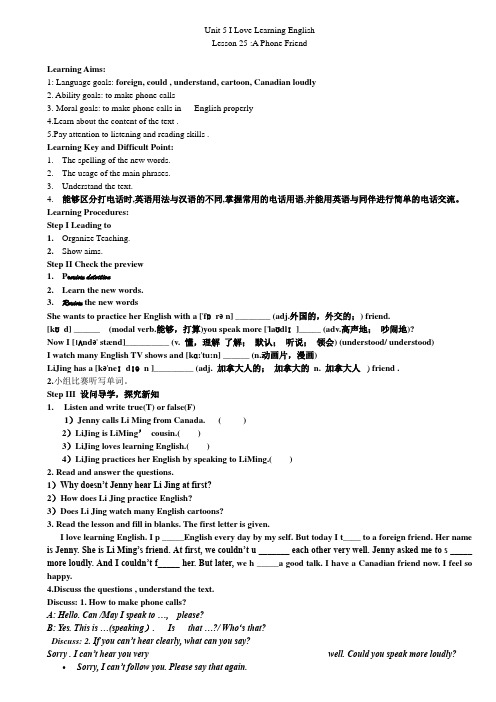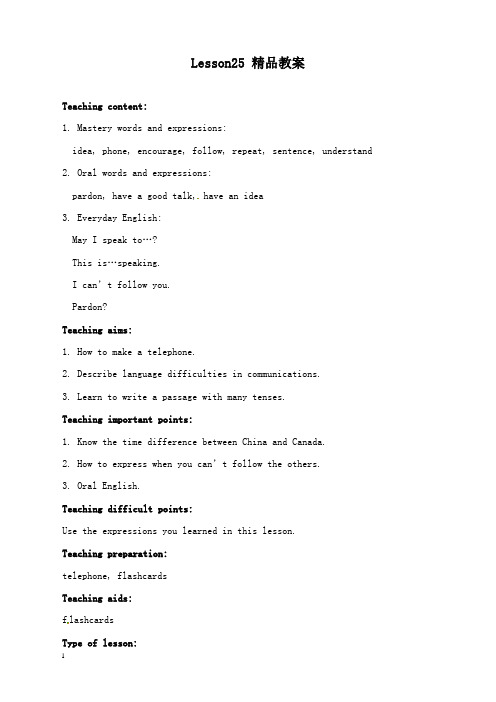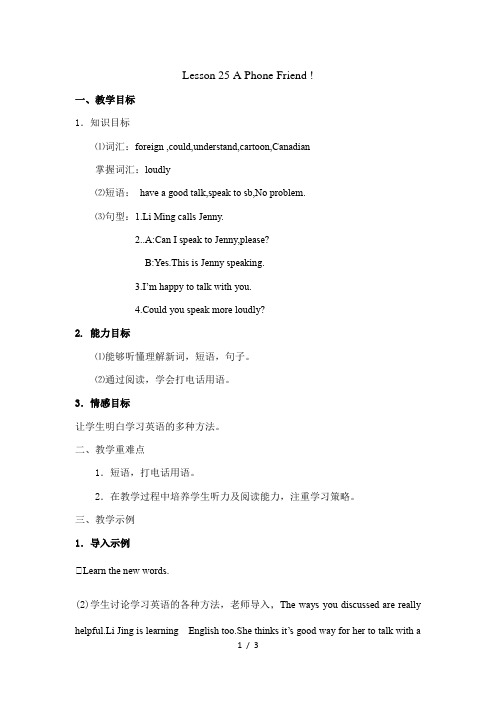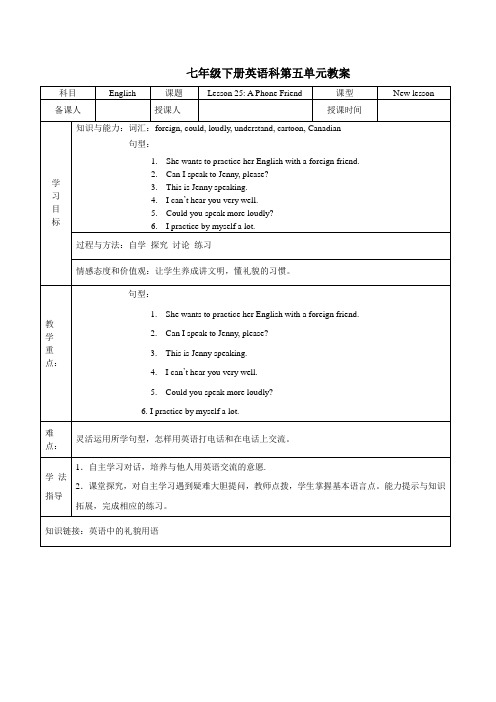冀教版英语七年级下册Unit 5 Lesson 25 A Phone Friend. 教案设计
- 格式:doc
- 大小:17.50 KB
- 文档页数:2

Unit 5 I Love Learning EnglishLesson 25 :A Phone FriendLearning Aims:1: Language goals: foreign, could , understand, cartoon, Canadian loudly2. Ability goals: to make phone calls3. Moral goals: to make phone calls in English properly4.Learn about the content of the text .5.Pay attention to listening and reading skills .Learning Key and Difficult Point:1.The spelling of the new words.2.The usage of the main phrases.3.Understand the text.4.能够区分打电话时,英语用法与汉语的不同,掌握常用的电话用语,并能用英语与同伴进行简单的电话交流。
Learning Procedures:Step I Leading toanize Teaching.2.Show aims.Step II Check the preview1.P review detection2.Learn the new words.3.Review the new wordsShe wants to practice her English with a ['fɒrən] ________ (adj.外国的,外交的;) friend.[kʊd] ______ (modal verb.能够,打算)you speak more ['laʊdlɪ]_____ (adv.高声地;吵闹地)?Now I [׀ʌndə' stænd]__________ (v. 懂,理解了解;默认;听说;领会) (understood/ understood)I watch many English TV shows and [kɑ:'tu:n] ______ (n.动画片,漫画)LiJing has a [kə'neɪdɪən ]_________ (adj. 加拿大人的;加拿大的n. 加拿大人 ) friend .2.小组比赛听写单词。


Lesson25 精品教案Teaching content:1. Mastery words and expressions:idea, phone, encourage, follow, repeat, sentence, understand 2. Oral words and expressions:pardon, have a good talk, have an idea3. Everyday English:May I speak to…?This is…speaking.I can’t follow you.Pardon?Teaching aims:1. How to make a telephone.2. Describe language difficulties in communications.3. Learn to write a passage with many tenses.Teaching important points:1. Know the time difference between China and Canada.2. How to express when you can’t follow the others.3. Oral English.Teaching difficult points:Use the expressions you learned in this lesson.Teaching preparation:telephone, flashcardsTeaching aids:f lashcardsType of lesson:new lessonTeaching procedures:Step 1. Talk about the weather with the students and ask “Who is on duty today?”Know about who is on duty next time.Step 2.Introduce the topic to the class.Ask the class:1. Why should you spend so much time learning English?2. How many people speak Chinese in the world?3. How many people speak English in the world?4. Why should so many countries use English?Tell them if they don’t know the answers, it doesn’t matter. What we wi ll learn is about the topic?Step 3.Play a riddle: You answer me, although I never ask you questions. What am I? (A telepho ne.) The teacher asks the question: Can you guess whatwe will learn in this text?[Step 4. Come to “THINK ABOUT IT!”1. How often do you make phone calls to your friends?2. Is it hard to understand your friends when they speak English? If so, what can you ask them to do?The students can answer the first question in English. If they can’t answer the second, they can answer in Chinese.Step 5. Listen to the tape. Write true (T) or false(F).1. Jenny calls Liming from Canada.2. Li Jing is Li Ming’s cousin.3. Li Jing loves learning English4. Li Jing practice her English by speaking to Li Ming.Step 6. Ask the students to read the dialogue silently and check the answers.Step 7.Divide the class into several groups. Each group has three people. Read the text in roles in class. Practice for a while then let several groups go to the front to act it out.Step 8. Come to “LET’S DO IT!”Make up a dialogue with a partner. Act out a phone call between two friends. One is in China; the other is in the U.S. Try to use exp ressions you learned in this lesson.When the students are making the dialogue, the teacher tours the c lass. If they meet any trouble, try your best to help them. After five minutes, make sure they are done. Let some students act the dialogue out in front of the class.Do the others hear it clearly? Ask some questions about their passages in order to test their listening ability.Homework:1. Finish off the activity book.2. Go on the reading in the student book.Summary:“Pardon” is a very popular expression in Engl ish when you can’t follow the others. It is useful in English classes. If the teacher takes the sentence as important spoken English, we can use it more often.。

Lesson 25 A Phone Friend !一、教学目标1.知识目标⑴词汇:foreign ,could,understand,cartoon,Canadian掌握词汇:loudly⑵短语:have a good talk,speak to sb,No problem.⑶句型:1.Li Ming calls Jenny.2..A:Can I speak to Jenny,please?B:Yes.This is Jenny speaking.3.I’m happy to talk with you.4.Could you speak more loudly?2. 能力目标⑴能够听懂理解新词,短语,句子。
⑵通过阅读,学会打电话用语。
3.情感目标让学生明白学习英语的多种方法。
二、教学重难点1.短语,打电话用语。
2.在教学过程中培养学生听力及阅读能力,注重学习策略。
三、教学示例1.导入示例⑴Learn the new words.(2)学生讨论学习英语的各种方法,老师导入,The ways you discussed are really helpful.Li Jing is learning English too.She thinks it’s good way for her to talk with aforeigner .Do you agree with her?Let’s find out.2.重点突破示例⑴听力OK, class.Please listen to the text and write true or false.(参考答案:F T T F)听录音并检查学生理解情况。
⑵限时阅读,小组讨论翻译,理解课文。
①OK. Now let’s learn the text in your groups.②小组代表翻译课文。
有感情大声朗读课文。
语言点1.Call sb=call sb up/make a call to sb/ring sb up,给某人打电话。


Lesson 25 A Phone Friend教学设计【教学目标】1.Master the words and phrases:foreign, could, understand --; speak to, talk with--2.Ss can use reflexive pronouns and modal verbs, and learn to make phone calls in English. 【教学重难点】重点:掌握本课重点单词、短语及句型。
难点:让学生能使用反身代词和情态动词,并学会用英语打电话。
【课时安排】1课时【授课时间】2020年( )月( )日星期( )【教学过程】一、导入环节(2分钟)(一)导入新课,板书课题导入语:Good morning, class. How are you? Today, we are going to learn:Lesson 25:A Phone Friend(二)出示学习目标过渡语:First ,let’s read the learning goals together.1.我要掌握单词和短语:everybody, weekend --; have a great/good weekend--2.通过学习,我要学会使用反身代词和情态动词,并学会用英语打电话。
过渡语:I believe everyone can achieve your goal? Can you ? Let’s begin .二、先学环节(15分钟)过渡语:First look at the guides carefully and then finish the tasks step by step.(一)出示自学指导1.读课文,划出不熟悉的单词、短语和句子2.完成自学检测(二)自学检测反馈I.用括号内所给词的适当形式填空1.Sorry, I can’t (follow) you.2.Pardon? Please say it (slow).3.Hello, this is Li Ming (speak).4.Do you often practice(play) the piano?5.Tom can’t work out the problem by (he).【Keys】 1.follow 2.slowly 3.speaking 4.playing 5.himselfII.英汉互译1.Can I speak to ---please?_____________________2.This is ---speaking ________________3.没问题_________4.说英语__________5. say sorry to sb____________6.a lot __________ 7.have a good talk___________ 8.让某人做某事_______________【Keys】1.请让---接电话好吗? 2.我是--- 3.no problem 4.speak English 5.向某人道歉 6.常常,经常;长时间地7.谈得很好8.ask sb to do sthIII.根据汉语完成句子1. 喂!请让鲍勃接电话, 好吗?Hello! Can I ________ ________ Bob, please?2. 你说的话我听得不是很清楚。
Lesson25 A Phone Friend 教学设计一.教学目标:1.知识与能力目标:(1.)掌握和运用反身代词(2.)运用所学了解英语学习的方法。
(3.)初步运用情态动词can谈论“能”与“不能”。
2.过程与方法目标:(1.)通过提供活动评价标准,学生能够根据标准进行自我评价,并通过组外评价能更加了解自己的学习情况。
(2.)通过对话练习,学生能够锻炼听力能力和口语表达能力。
3. 情感和态度目标:(1.) 通过合作交流,获取自己所需要的信息,明确在学习和生活中要积极与人合作,相互帮助,共同发展。
在小组评价、讨论等活动中培养学生的团队合作精神。
(3.)通过本课学习,培养学生学习英语的兴趣,使学生能够明白英语的重要性,并养成良好的英语学习习惯,掌握正确的英语学习方法。
二.教学重点、难点:教学重点:(1.)掌握本课重点词汇和常见英语表达:foreign understand Canadian cartoonNo problem! Watch TV listen to English music(2.)掌握反身代词oneself的不同形式和常见表达。
教学难点:如何让学生表达英语学习的方法。
三.教学资源:课本、板书、PPT四.教学过程五.板书六.教学反思:通过本节教与学活动,并与同学们交流,达到了教学目标任务,经过认真总结,反思如下:优点:1、“温故而知新”落在了实处,对电话用语的学习,采用习题训练,对以前的知识进行复习巩固,学生用了最少的时间,收到了最大效果。
2、本课涉及到的所有问题,均通过自主学习、主动参与、合作交流的方式得以解决。
把学习化为交际,这最大限度满足了学生想用英语交流的渴望。
3、在本课英语教学过程中,我注重了最大限度地营造民主平等、和谐默契的课堂氛围。
采用多种教学方法使学生思维活跃,学习热情高涨。
4、本课听、说、读、写训练充分、到位,使学生语言技能训练落在了实处。
缺点:部分同学课前预习不到位,课堂参与不主动,以后教学过程中,应多关心潜能生的发展性学习。
第一课时Lesson 25:A Phone Friend教学目标1. 掌握单词:foreign, could, understand, cartoon, Canadian短语:speak to, talk with, more loudly, speak English, learn English, by oneself, have a good talk 2,.掌握和运用用英语打电话的句型:She wants to practice her English with a foreign friend, but she doesn’t have any.—Can I speak to Jenny, please?—Yes.This is Jenny speaking.Is that you,Li Ming?I can’t hear you very well.Could you speak more loudly?Sorry,I can’t follow you.Please say that again.You speak English very well.—How do you practice by yourself?—I watch many English TV shows and cartoons.Jenny and Li Jing have a good talk.3.能使用反身代词和情态动词。
4.能使用本课的词汇及句式用英语打电话。
5.能听懂关于有礼貌的电话用语的对话。
教学重点、难点1.学会运用用英语打电话的词或短语:foreign, could, understand, cartoon, Canadian, speak to, talk with, more loudly, speak English, learn English, by oneself, have a good talk2.学会使用用英语打电话的句型:She wants to practice her English with a foreign friend, but she doesn’t have any.—Can I speak to Jenny, please?—Yes.This is Jenny speaking.Is that you, Li Ming?I can’t hear you very well.Could you speak more loudly?Sorry,I can’t follow you.Please say that again.You speak English very well.—How do you practice by yourself?—I watch many English TV shows and cartoons.Jenny and Li Jing have a good talk.3.能使用反身代词和情态动词。
Lesson 25:A Phone Friend
Teaching procedures:
Step1: Daily greetings
T: Hello, everyone. How are you today?
S: I’m fine. And you?
T: Me, too. Nice to meet you.
S: Nice to meet you, too.
Step2: Show “Studying aims”( 出示“学习目标”)
1.To recite the new words of Lesson 25.
2. To master how to make a phone call(打电话)in English .
1)May/Can I speak to…?2)Who’s that?
3)This is…speaking./Speaking.4)Is that…?
Step3: Read and recite these words within 5 minutes.
1. Teach and read the new words of L25.
2.Ask the students to recite the new words by themselves.
3.Check the new words each other.
Step4: Listen to the audiotape carefully and finish the following exercise.
1. First,show the exercise “Please write true (T) or false (F)” .
2. Then , let the students listen to the audiotape with the questions.
3.Check the answers one by one.
Step6: Reading and asking about the dialogue.
1.Read and translate this dialogue within 2' and underline the words
or sentences that you don’t know.
2.Some poor students show some difficulties that they can’t understand,
and the
other students explain them. If all the students can’t understand the sentence and the
teacher will give some explanations in class.
后进生
Step6: Practicing and acting
1. Practice the dialogue in groups, and after 3' let’s have a match to see who
can act best!
2. Ask some groups to act the dialogue in class.
Step7:Important language points
1.打电话用语
1)打招呼:Hello!
2)找某人接电话:May /Could/ Can I speak to…?/ I’d like to speak to….
3)询问对方是谁以及答语:--Who’s that (speak)? /--This is… (speaking)./
4)请别挂断!(请稍等一会)Hold on, please.
2.Canada ['kænədə] 加拿大Canadian [kə'neɪdɪən] adj. 加拿大(人)的n.加拿大人
There is a city called Toronto in_________.
Jenny is from_________. She is____________.
Li Jing has a __________ friend now.
Some_____________ speak French.
Step8:Summary(小结)
So much for today. Now, Let’s have a test to see who can do best!。